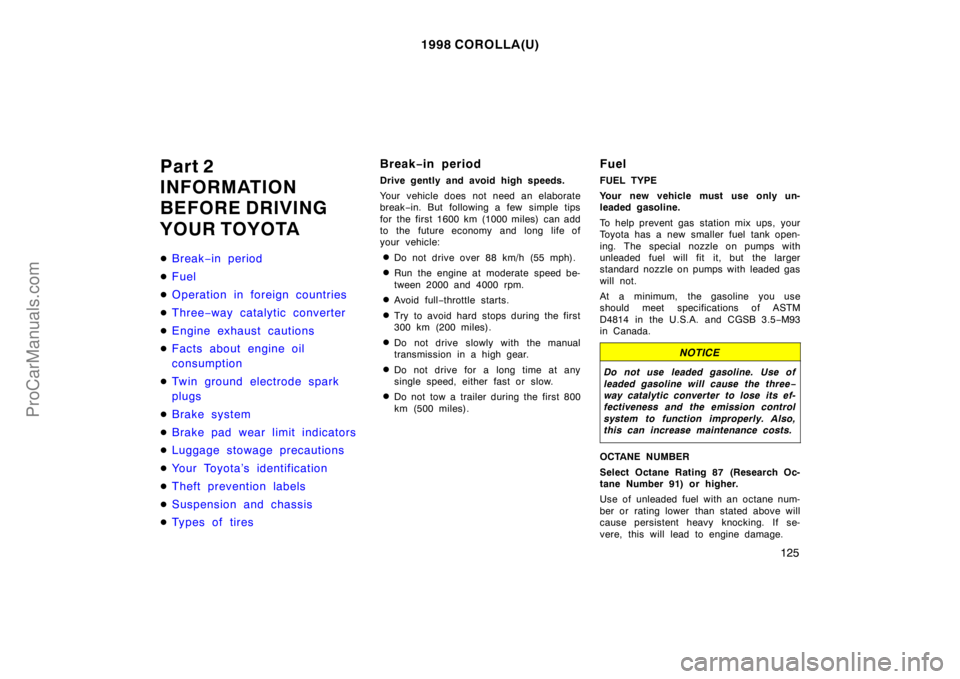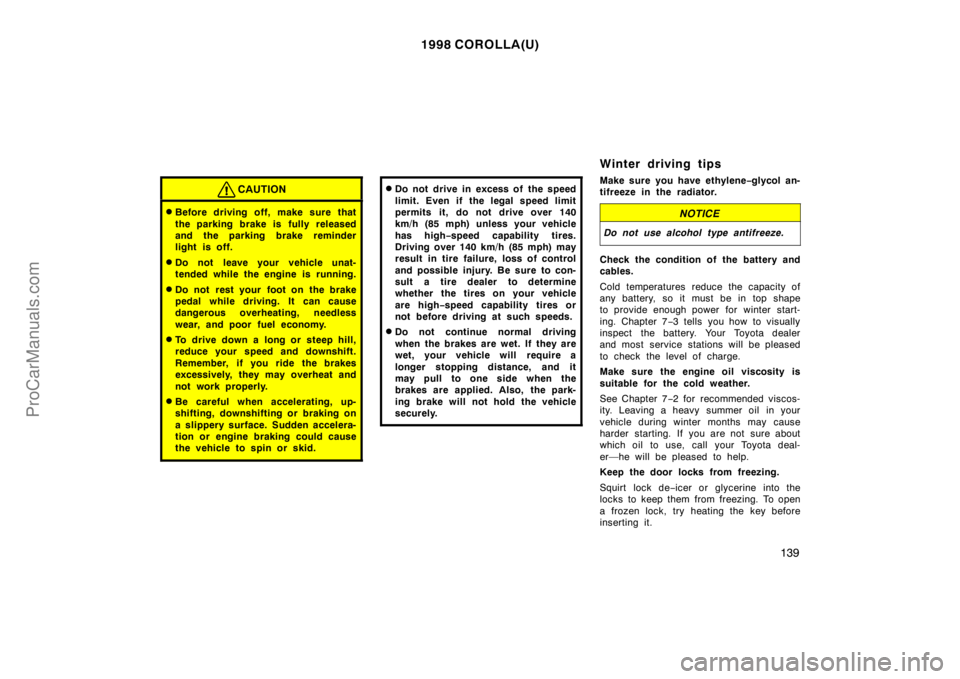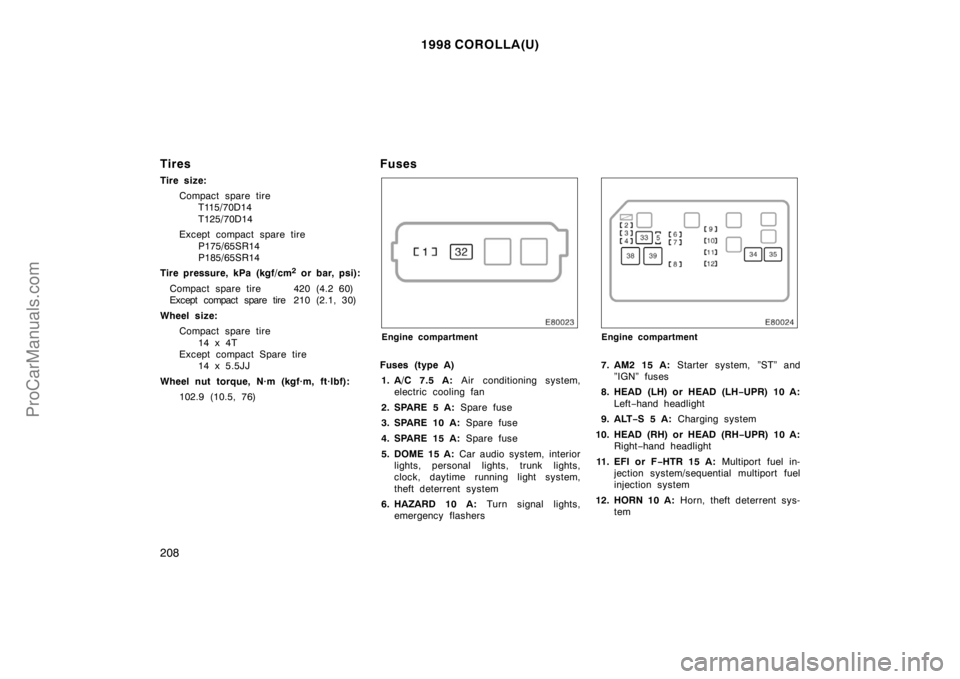Page 7 of 204
1998 COROLLA(U)
7
Indicator symbols on the instrument panel
Brake system warning light∗
1
Seat belt reminder light∗
1
Discharge warning light∗
1
Malfunction indicator lamp∗
1
Low oil pressure warning light∗
1
Anti-lock brake system warning light∗
1
Open door warning light∗
1
(type A)
(type B)SRS airbag warning light∗
1
Low windshield washer fluid level warning light∗
1
Low fuel level warning light∗
1
(type A)
(type B)
Turn signal indicator lights
Headlight high beam indicator light
Overdrive−off indicator light
Cruise control indicator light
∗
2
Rear window defogger indicator light
∗
1: For details, see ”Service reminder indicators and warning
buzzers” in Chapter 1−5.
∗
2: If this light flashes, see ”Cruise control” in Chapter 1−6.
ProCarManuals.com
Page 117 of 204

1998 COROLLA(U)
125
Part 2
INFORMATION
BEFORE DRIVING
YOUR TOYOTA
�Break−in period
�Fuel
�Operation in foreign countries
�Three−way catalytic converter
�Engine exhaust cautions
�Facts about engine oil
consumption
�Twin ground electrode spark
plugs
�Brake system
�Brake pad wear limit indicators
�Luggage stowage precautions
�Your Toyota’s identification
�Theft prevention labels
�Suspension and chassis
�Types of tires
Break−in period
Drive gently and avoid high speeds.
Your vehicle does not need an elaborate
break−in. But following a few simple tips
for the first 1600 km (1000 miles) can add
to the future economy and long life of
your vehicle:
�Do not drive over 88 km/h (55 mph).
�Run the engine at moderate speed be-
tween 2000 and 4000 rpm.
�Avoid full−throttle starts.
�Try to avoid hard stops during the first
300 km (200 miles).
�Do not drive slowly with the manual
transmission in a high gear.
�Do not drive for a long time at any
single speed, either fast or slow.
�Do not tow a trailer during the first 800
km (500 miles).
Fuel
FUEL TYPE
Your new vehicle must use only un-
leaded gasoline.
To help prevent gas station mix ups, your
Toyota has a new smaller fuel tank open-
ing. The special nozzle on pumps with
unleaded fuel will fit it, but the larger
standard nozzle on pumps with leaded gas
will not.
At a minimum, the gasoline you use
should meet specifications of ASTM
D4814 in the U.S.A. and CGSB 3.5−M93
in Canada.
NOTICE
Do not use leaded gasoline. Use of
leaded gasoline will cause the three−
way catalytic converter to lose its ef-
fectiveness and the emission control
system to function improperly. Also,
this can increase maintenance costs.
OCTANE NUMBER
Select Octane Rating 87 (Research Oc-
tane Number 91) or higher.
Use of unleaded fuel with an octane num-
ber or rating lower than stated above will
cause persistent heavy knocking. If se-
vere, this will lead to engine damage.
ProCarManuals.com
Page 131 of 204

1998 COROLLA(U)
139
CAUTION
�Before driving off, make sure that
the parking brake is fully released
and the parking brake reminder
light is off.
�Do not leave your vehicle unat-
tended while the engine is running.
�Do not rest your foot on the brake
pedal while driving. It can cause
dangerous overheating, needless
wear, and poor fuel economy.
�To drive down a long or steep hill,
reduce your speed and downshift.
Remember, if you ride the brakes
excessively, they may overheat and
not work properly.
�Be careful when accelerating, up-
shifting, downshifting or braking on
a slippery surface. Sudden accelera-
tion or engine braking could cause
the vehicle to spin or skid.
�Do not drive in excess of the speed
limit. Even if the legal speed limit
permits it, do not drive over 140
km/h (85 mph) unless your vehicle
has high−speed capability tires.
Driving over 140 km/h (85 mph) may
result in tire failure, loss of control
and possible injury. Be sure to con-
sult a tire dealer to determine
whether the tires on your vehicle
are high−speed capability tires or
not before driving at such speeds.
�Do not continue normal driving
when the brakes are wet. If they are
wet, your vehicle will require a
longer stopping distance, and it
may pull to one side when the
brakes are applied. Also, the park-
ing brake will not hold the vehicle
securely.
Winter driving tips
Make sure you have ethylene−glycol an-
tifreeze in the radiator.
NOTICE
Do not use alcohol type antifreeze.
Check the condition of the battery and
cables.
Cold temperatures reduce the capacity of
any battery, so it must be in top shape
to provide enough power for winter start-
ing. Chapter 7−3 tells you how to visually
inspect the battery. Your Toyota dealer
and most service stations will be pleased
to check the level of charge.
Make sure the engine oil viscosity is
suitable for the cold weather.
See Chapter 7−2 for recommended viscos-
ity. Leaving a heavy summer oil in your
vehicle during winter months may cause
harder starting. If you are not sure about
which oil to use, call your Toyota deal-
er—he will be pleased to help.
Keep the door locks from freezing.
Squirt lock de−icer or glycerine into the
locks to keep them from freezing. To open
a frozen lock, try heating the key before
inserting it.
ProCarManuals.com
Page 197 of 204
1998 COROLLA(U)
205
Part 8
SPECIFICATIONS
�Dimensions and weight
�Engine
�Fuel
�Service specifications
�Ti r es
�Fuses
Dimensions and weight
Overall length mm (in):
4420 (174.0)
Overall width mm (in):
1695 (66.7)
Overall height mm (in):
1385 (54.5)
∗
Wheelbase mm (in):
2465 (97.0)
Front tread mm (in):
1460(57.5)
Rear tread mm (in):
1450(57.1)
Vehicle capacity weight
(occupants+luggage)
kg(lb): 385 (850)
∗:Unladen vehicle
Engine
Model:
1ZZ−FE
Type:
4 cylinder in line, 4 cycle, gasoline
Bore and stroke, mm (in.):
79.0 x 91.5 (3.11 x 3.60)
Displacement, cm
3 (cu. in.):
1794 (109.5)
ProCarManuals.com
Page 198 of 204
1998 COROLLA(U)
206
Fuel
Fuel type:
Unleaded gasoline, Octane Rating 87 (Re-
search Octane Number 91) or higher
Fuel tank capacity, L (gal., Imp. gal.):
50 (13.2, 11.0)
Service specifications
ENGINE
Valve clearance (engine cold), mm (in.):
Intake 0.15—0.25 (0.006—0.010)
Exhaust 0.25—0.35 (0.010—0.014)
Spark plug type:
DENSO K16TR11
NGK BKR5EKB−11
Spark plug gap, mm(in.):
1.1 (0.043)ENGINE LUBRICATION
Oil capacity (drain and refill), L (qt., Imp.
qt.):
With filter 3.7 (3.9, 3.3)
Without filter 3.5 (3.7, 3.1)
Oil grade:
API grade SH, ”Energy−Conserving II”
or SJ, ”Energy−Conserving” multigrade
engine oil or ILSAC multigrade engine
oil is recommended.
Recommended oil viscosity (SAE):
ProCarManuals.com
Page 200 of 204

1998 COROLLA(U)
208
Tires
Tire size:
Compact spare tire
T115/70D14
T125/70D14
Except compact spare tire
P175/65SR14
P185/65SR14
Tire pressure, kPa (kgf/cm
2 or bar, psi):
Compact spare tire 420 (4.2 60)
Except compact spare tire 2 1 0 ( 2 . 1 , 3 0 )
Wheel size:
Compact spare tire
14 x 4T
Except compact Spare tire
14 x 5.5JJ
Wheel nut torque, N·m (kgf·m, ft·lbf):
102.9 (10.5, 76)
Fuses
Engine compartment
Fuses (type A)
1. A/C 7.5 A: Air conditioning system,
electric cooling fan
2. SPARE 5 A: Spare fuse
3. SPARE 10 A: Spare fuse
4. SPARE 15 A: Spare fuse
5. DOME 15 A: Car audio system, interior
lights, personal lights, trunk lights,
clock, daytime running light system,
theft deterrent system
6. HAZARD 10 A: Turn signal lights,
emergency flashers
Engine compartment
7. AM2 15 A: Starter system, ”ST” and
”IGN” fuses
8. HEAD (LH) or HEAD (LH−UPR) 10 A:
Left−hand headlight
9. ALT−S 5 A: Charging system
10. HEAD (RH) or HEAD (RH−UPR) 10 A:
Right−hand headlight
11 . E F I o r F−HTR 15 A: Multiport fuel in-
jection system/sequential multiport fuel
injection system
12. HORN 10 A: Horn, theft deterrent sys-
tem
ProCarManuals.com